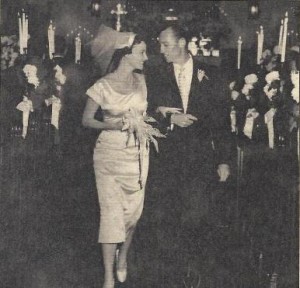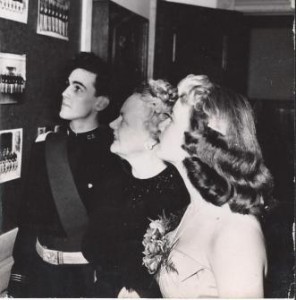September 3rd, 2013

Hello from the cornfields of Iowa
“I’m happy wherever I go, whatever I do. I’m happy in Iowa, I’m happy here in California.” Ashton Kutcher (Some of us are happy here too, Ashton”). Have you noticed he seems like kind of a nice guy? Not surprised.
Dear Huffington Post,
I really like your site. In fact, sometimes I even write for your site. But, the other day I ran across a piece from your site on Twitter about a quest for style in Iowa. Apparently, this was such a strange notion that the Onion had to do their own version, which was pretty good, and in some cases, pretty accurate. http://www.theonion.com/articles/iowa-fashion-week-begins,31579.
I’m glad you visited, though. I actually liked the video piece, full of charm and good characters, but your written piece left out some of that charm. So, readers all over the U.S. were left with just these photos as a representation of all of us here in the fields of dreams…. http://www.huffingtonpost.com/2013/08/29/iowa-fashion-style_n_3831853.html?utm_hp_ref=mostpopular
So, with your permission, (can I have permission?) I’ll use your photos but add a couple of my own.
Here’s your picture of where we shop….

You really should have shown Walmart. We have some good ones here. Photo courtesy Huffington Post.
But sometimes I shop in places that aren’t in malls, with, like, cool brick walls and everything…

Like this place…called Studio 427, not in mall. Courtesy Studio 427, Sioux City
or this place
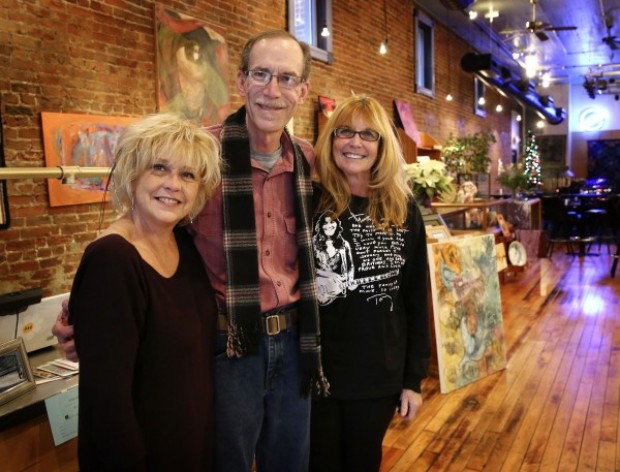
Indigo Palette, also in Sioux City, Iowa. Here, I’ll prove to you that this isn’t in a mall….

Not a mall. So, there’s only two or three places that aren’t a mall, I still thought I’d show them to you.
Then we proceeded to the type of hair salon, we all frequent, from your story…

You kind of picture Aunt Bea here, don’t you? Photc courtesy Huffington Post.
Here’s my hair salon, if you’d like to add this to your follow up story…

This doesn’t suck too bad. Bliss salon, Sioux City. Not in mall. Have you noticed I’m trying to get you to come to Sioux City? Photo courtesy Bliss Salon
Not done yet, but neither were you, so we’ll move onto the clothing styles, particularly our choice of denim… Here’s yours..

Here’s your Iowa denim fashion statement. I actually kind of like overalls, and they work on this guy. Photo courtesy Huffington Post again. I would imagine that probably only about .001 percent of us wear these but thank you anyway…

I found one just about like this…so you were darn close here… Photo courtesy Huffington Post again

Ok, a bit different, but not bad…. Photo courtesy La Ventura and the Weekender, yes, Sioux City again.

Two young Sioux City kids wishing they had overalls… I think I’ll find them and buy them some. Photo courtesy La Ventura and The Weekender.
Here’s another jeans picture from Iowa, taken of my husband during a protest.

Oh, shit, are these dad jeans?
But wait there’s more….
I loved your beard picture of the guy that lived in Paris and moved back to Iowa. I can’t find a damn thing even close in Sioux City, so you win big here….

This beard is awesome, great job. Photo courtesy Huffington Post again. You guys are great and so is this beard..
Nothing remotely like it that I could find in Sioux City, so here’s two guys I know, with rather short beards.

Here’s two friends who apparently need to work on their beard length if they want to be a bit freakier than they are. Photo courtesy Garie Lewis and Mike Langley.
I do get it, though. It’s easy to pigeonhole Iowa. I was the executive producer of a documentary called “Bully”, partially filmed here in my home town. My friend, Lee Hirsch, who I love, didn’t show much of Iowa. In fact, Sioux City looked like one bus, one train track, and a school. Here’s a shot…

Sioux City in “Bully”, footage courtesy of Lee Hirsch, and I think the Weinstein Company too. Thank you, Mr. Weinstein and thank you for buying our film too. 🙂 Will you please buy my next documentary? Call me….

Heck, we’ve got bridges and everything here in Sioux City, and cars too….
Sometimes, half the town gets together for a big party close to the fourth of July. There’s usually about 30,000 of us and some good bands too, so I am inviting you to visit and get kind of a cross section of types, because, you’ll get the general idea that we are a bit more nuanced here in the heartland than people think.
Here’s the party….

Gosh, we can fit about half the town here…. and just the denim fashions alone will give you much to work with. Photo above and below courtesy Saturday in the Park.

These folks aren’t from here, but we let people like this play here and no one has to pay to get in. So, join us next year, ok? I like Melissa’s jeans.
I’ll close by saying that we come in all shapes and sizes here in flyover America, so do come visit again, particularly in Sioux City. We need you. Poor Sioux City is doubly not blessed by not only being in a flyover state, but for having the unfortunately airport designation SUX. I’m not making that up. So, on your purchase of a ticket from whatever coast on our one and only airline, you can see it yourself. And, you’ll get a free gift basket, with items such as this…


All SUX photos courtesy Sioux City gifts….
and my personal favorite…

So, come visit and be nice, or as Glinda once said, be gone, before I drop a Walmart on you. 🙂
Most Sincerely Yours,
Cindy Waitt
This is me and my family. When we’re in California, we wear dark glasses, so we can pretend we are cool too.

And finally, can I still write for you?
Comments (14)
August 12th, 2013

This was happening when I was in elementary school.
“At some point in our lifetime, gay marriage won’t be an issue, and everyone who stood against this civil right will look as outdated as George Wallace standing on the school steps keeping James Hood from entering the University of Alabama because he was black.” George Clooney

And this is still happening now….
Do you ever watch a documentary on the civil rights movement of the 1950’s and 60’s and cringe when it comes to scenes of furious white people hurling stones, taunting, and overall verbally and physically assaulting movement activists? In 2013, it seems ludicrous, shameful, and yes, embarrassing. If you haven’t, do it. And go ahead, cringe. We should.
If footage from then seems like coverage of the Dark Ages, consider this. If you are over 50, that outward display of hatred was happening in your lifetime.
Today’s children routinely study atrocities like the Holocaust, the Salem Witch trials, and the treatment of African Americans and Native Americans, as well as women, in our country. If they aren’t studying them, they should be, and often. It’s simply history now, that discipline that takes us back to another time while we see the actions and decisions of our ancestors from modern sensibilities. The behaviors seem almost insane from our point of view today, particular the behaviors of people living in our lifetime, in our country, and perhaps in our own cities.
Jump forward 50 years to 2013 to the marriage equality movement and the overall movement that started out of a bar called the Stonewall Inn in Greenwich Village in New York in 1969. We’ve come a long way. Just a few headlines from this year:
Supreme Court DOMA Decision Rules Federal Same-Sex Marriage Ban Unconstitutional
THE END OF “EX-GAY’ CONVERSION THERAPY.
Poll: Support for gay marriage hits high after ruling
As my friend and colleague Jackson Katz said years ago, “That train has left the station”. And it has. But, as a person who’s been involved in some movements, I know that for every push, there’s a “push back”. And oh, what a push back.
Let’s just take my beloved hometown, Sioux City, Iowa. I sing it’s praises all the time, but not on this one. In fact, Sioux City has a rather disturbing history of “the push back”. Here’s a few highlights and a few stars of the anti equality bunch that our own children and grandchildren may be reading about 50 years from now…or sooner.
1950’s, Sioux City, Iowa: As Neil Miller writes about in his classic “Sex Crime Panic”, described here. “Following the brutal murders of two children in Sioux City, Iowa, in 1954, police, in an attempt to quell public hysteria, arrested 20 men whom the authorities never claimed had anything to do with the crimes. Labeled as sexual psychopaths under an Iowa law that lumped homosexuals together with child molesters and murderers, the men were sentenced to a mental institution until cured.” If I wasn’t there in the mid 50’s, I was on the way…
2004, Sioux City, Iowa, from The Advocate “The Sioux City, Iowa, city council has rejected a proposal to make it illegal to discriminate on the basis of a person’s sexual orientation. The council voted 4-1 Monday against adding gays and lesbians to the current city law, which makes it illegal to discriminate against people in jobs, accommodations, and housing on the basis of race, creed, color, national origin, religion, ancestry or disability.The Human Rights Commission asked the council to add sexual orientation to that group of protected classes. Mayor Dave Ferris and Councilmen Marty Dougherty and Jason Geary said they voted against the measure based on their religious beliefs involving homosexuals. Councilman Craig Berenstein said he voted no because he wanted more time to study the proposal.Councilwoman Karen Forneris cast the only vote in favor of adding sexual orientation to the law. Five Iowa cities have included sexual orientation in their ordinances—Ames, Cedar Rapids, Davenport, Des Moines and Iowa City. That time I was there. A group of us stood outside city hall to protest that one. I should have done the same in the mid 1990’s when a religious group objected to my having an LGBT section in my store. A new council finally went along with adding sexual orientation in 2008, as the state of Iowa had already added it.
2010, Sioux City’s own Pastor Cary Gordon and the Cornerstone World Outreach were leaders in the efflort to have Iowans oust three Iowa Supreme Court justices whose ruling was part of a 7-0 unanimous vote that legalized same sex marriage in the state of Iowa. The three justices were ousted, but later received the “Profiles in Courage” awards from the Kennedy Center in 2012.
2011, Sioux City’s own, Bob Vander Plaats and The Family Leader gained national recognition for its pledge, “The Marriage Vow: A Declaration of Dependence upon MARRIAGE and FAMILY”, which it asked 2012 presidential hopefuls to sign. Vander Plaats himself also gained recognition, being referred to in one news post as a “kingmaker.”
I hope as our descendants study the history of our nation, as well as our own home town, some of these things will be looked at with new eyes and looked at hard. My sense is that the cringe factor is and will be strong, as it should. Just recently there has been a controversy concerning the appointment of a gay man, Scott Raasch, to the Sioux City Human Rights Commission, following the uncovering of some unpleasant comments Raasch made to anti gay rights Pastor Cary Gordon three years ago. Gordon has asked for Raasch’s removal. http://siouxcityjournal.com/news/local/govt-and-politics/cornerstone-pastor-calls-for-new-sioux-city-human-rights-commissioner/article_04263e87-485c-5697-921a-e0729251192e.html The city council has just yesterday stated that Raasch will stay on the commission. That was the push, I await breathlessly for the push back.
I also await the day when we, as a country, and as fellow humans recognize and learn from our own cringe worthy actions and behaviors, that gay rights and marriage equality are simply human rights, and deserve our full and unqualified support.
Comments (4)
July 28th, 2013
By Eric Blumberg

Eric Blumberg is an award-winning radio talk show host who also has gained acclaim as a reporter and columnist for several radio stations and local weekly newspapers. Born in New York City in 1952, he received his B.A, in Media Studies at Hunter College and spent two years at the graduate school of journalism at the University of Texas in Austin. He spent the majority of his broadcast journalism career in Austin, where he was recognized four times as the city’s best radio talk show host. Blumberg has taught journalism at Austin Community College as well as English as a second language and writing at Western Iowa Tech Community College in Sioux City. He now lives in Sioux City, Iowa with his wife, Cindy Waitt. He has three daughters and one stepson.
To U.S. Residents Living Outside Iowa’s Fourth Congressional District:
As a resident of Sioux City, Iowa and a member of the city’s Human Rights Commission, I want to offer all of you my sincerest apologies for the continued stupidity of my U.S. Congressman, Steve King.
His most recent hateful comments regarding those who would benefit from the Immigration Reform Bill are not necessarily those of his constituents. Nonetheless, you might get the impression that those Iowans of King’s 5th district are mindless bigots in the fashion of our Congressman.
Iowans are fair people, who, by and large, do not condemn other people simply based on their race, gender, sexual orientation, religion or, in this case, their current immigration status.
While I do understand what the Congressman is trying to say, I don’t understand why he chose to say it in the fashion he did.
Subsequent to his initial remarks from this July, he took the floor of the Congress to explain himself more thoroughly. In that statement, he, once again, alluded to his belief that the overwhelming majority of those minors who would receive a path to U.S. citizenship are working for Mexican drug cartels in an effort to supply us with the illegal substances we crave.
King stood by his statement that for each valedictorian there are 100 drug mules, adding that there cannot be any doubt of his beliefs since they are backed by logic and scientifically empirical data.
To me, that means that for every 101 undocumented teens living in the U.S., 100 are criminals. I find that hard to believe. However, if this is so, I want statistical proof. Not a guess or an assumption based on personal opinion, but mathematical certainty based on numbers derived from a credible source rather than out of his ass.
I’m well aware the 5th District voters spoke in 2012 and re-elected him by another large margin, however, that doesn’t mean we can’t speak up when faced with unrelenting ignorance and idiocy.
I’m also aware there is no recourse here in Iowa to recall King and am also aware he is too stupid to realize how wrong he is. Thus, you will never receive an apology from him.
The best we can do here in Iowa’s 4th District is to apologize for him and trust the rest of the country does not look too harshly on us since we are not bigots, but simply a group of inherently good people represented by one.
Comments (2)
January 26th, 2013
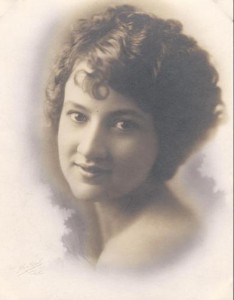
Mildred Emma Armstead, our grandmother, 1904-1990. We called her “Momo”
“Taught from their infancy that beauty is woman’s scepter, the mind shapes itself to the body, and roaming around its guilt cage, only seeks to adorn its prison.”
I do not wish them to have power over men; but power over themselves.” Mary Wollenstonecraft
My maternal grandmother’s portrait is in the lobby of the Orpheum theater in Sioux City, Iowa. It’s a former vaudeville and movie palace built in her heyday, in 1927, lovingly re- imagined and restored by the people of the city, with help from my two brothers. That’s why her picture hangs there. I often see people stop and stare at her. They comment to me often on her curly black haired, unusual, and sultry beauty. She had that particular 1920’s silent movie star or Zelda Fitgerald style, an angelic look that you figured hid a devilish sense of fun and mischief. She was fun and she was mischievous, so we named a piano bar after her, in the same building.
She was born in the heartland, and in a time and in circumstances when women were discouraged from looking inside, and prompted to find success in the beauty of their homes, their clothes, their children, and their lifestyles. At those things, she succeeded and succeeded as she was expected to …beautifully. Her luck with men, as many as she gathered, and there were many, wasn’t as good. Had she been born 50 years later, her life could have looked very different.
She had three husbands, in the days before women had three husbands. Two of the divorces weren’t her idea, one was, and that decision was a smart one. Her many married names gave rise to my often told joke that my own many married names made me sound like a law firm.
“ Were woman to ‘unsex’ themselves by claiming equality with men, they would become the most hateful, heathen and disgusting of beings and would surely perish without male protection.” Queen Victoria
She was raised by Victorians, was a child in Edwardian times, but came of age in the 1920’s. All of those times defined her. Her own name, before she add so many names to it, at birth in 1904 in Winchester, Kansas, was Mildred Emma Armstead, It was before the first world war that changed so much, before women could vote and in a time when it was said by her mother that ” a lady is only in the newspaper three times in her life…when she was born, when she was married, and when she died”. She broke that rule early on and most likely would have continued that if she’d had that chance. She was the first and only child of Minnie Louise Griffith and Dr. John B. Armstead, both of English descent whose families were early Kansas pioneers. Their home is a stately Victorian, that remind me of Amelia Earhart’s childhood home, not 20 miles away.
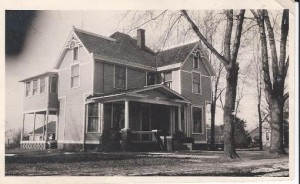
What she calls “My old home”, Winchester, Kansas.
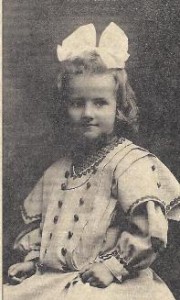
“Momo” about 1910

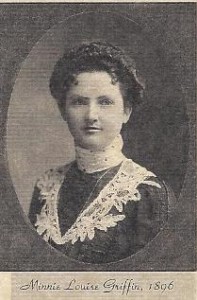
Dr. Armstead, who would travel on horseback to tend to patients in Jefferson County, suffered a fall at 37 that led to a brain tumor. He was buried on Mildred’s 10th birthday. Minnie did remarry, but was widowed twice more. Grandma, however, told me she had a good childhood and she had a kind and good- hearted mother who ” I’m afraid spoiled me a bit.” I suspect she spoiled her a lot. She also had an indulgent step father and a widowed grandfather who adored her. I can see from the old pictures she didn’t want for much, driving a swanky car in her teens, and always dressed exactly the way she was supposed to be dressed in that time. She was the first woman in her family to graduate from college in 1926 at Baker University in Baldwin, Kansas. It was there she met my grandfather William Gaston, a handsome, charismatic man with a beautiful singing voice . But before that, she was as they used to say “a belle”, and being that belle was a big deal.
“She tried to weave the strength of her father and the young beauty of her first love, the happy oblivion of her teens and her warm protected childhood into a magic cloak.” Zelda Fitgerald “Collected Writings”
A pretty child who grew into her beauty early and blessed with obvious charm and style, “Momo” never lacked for attention or for “suitors”, as she called them.
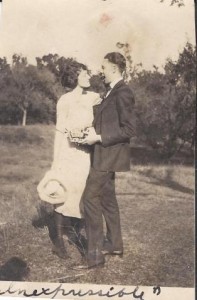
So, that’s where I get my old flirting tendencies…who is this guy?

Looks like the same guy, before she met Grandpa. I’ve found more of these, but the faces on the adoring men change…
I look through her old clippings, some faded to the point of being unreadable, and glean what I can about the details. Momo herself and my own mother Joan, her only child, have filled in the rest. The yellowing scrapbooks she saved gives credence to the years of stories of her little brush of fame in the days when women had just started bobbing their hair, sipping gin, driving cars, speaking out, and delightedly shocking their elders. Ironically, the college she attended didn’t allow sipping gin, or much of anything else. Dancing and card playing were also verboten. She must have found the time and place to indulge in a bit of wicked fun, although she may have followed the rules that made her want to break out of that box later. I like to think of her as a big time shocker to her adoring but strict Methodist family. Beyond that, though, according to her, a young lady’s popularity, style, and charm was the key to success and the eventual goal was to catch the right man. Gathering titles as a college beauty queen didn’t hurt. She did that, and apparently did it quite well. Her favorite story was about spring of 1926, where she was crowned, “Queen of the May” at her school.
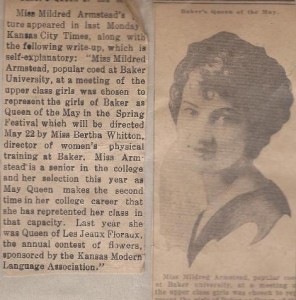
1926, Kansas City Times
According to this story, she’d had another beauty queen round the year before, as the “Queen of Les Jeaux Floraux”. That story calls her “The Queen of Beauty”. What followed theses queenly titles was the story she told the rest of her life and the story that always made me a little sad. She went to summer school one year at UC Berkeley in San Francisco, and a talent scout for Cecil B. DeMille noticed her. Contact was made to her family from De Mille’s office inquiring about the future of their daughter. Her straight laced mother and step father apparently found an acting career at that time way too scandalous, and that was the end of that. She returned to Baker. She may have felt sad then too, but I doubt too sad. She was on the track she set out for herself, or was set out for her, and my guess is that she was too damned happy to be so wanted to cry much over not becoming the next Gloria Swanson.

In California, on the trip where DeMille’s scout noticed her. No wonder, she looks so radiant here.
As much as she adored men (there are many pictures of her with men who weren’t my grandfather), she also surrounded herself with like minded women. She was the quintessential sorority girl, with a dance card. I actually found one. It was full. Her Zeta Tau Alpha girls were a big chunk of her life back then. When I didn’t pledge in the 70’s, she was dismayed and pronounced that she had serious doubts that I’d find the right type of man to marry. As hard as I’m sure she studied in Home Economics, her major, she never spoke of the academic side of college too much, at least not to me. An essay she did on Shelley and Keats is saved in a blue book, and is marked with a resounding “F”. She may have cried on that one, as she, like me, cried very easily.

The girls of Zeta Tau Delta, all with identical bobbed hair, Momo sixth from right, standing.
“Ev’ry morning, ev’ry evening
Ain’t we got fun?
Not much money, Oh, but honey
Ain’t we got fun?” Cole Porter
She did graduate, though, and she actually taught for a short time, until her impending marriage made her “unfit” to teach. As completely crazy as that sounds today, there were laws then in some states that barred married women from teaching. But marry she did in 1927, to the man who was to become the father of her first and only child, Joan Louise Gaston. Bill Gaston isn’t hard to describe. There wasn’t a microphone, a Scotch, or a woman he didn’t relish. He was smart, he was a story teller and singer, a great salesman who ended up as an international vice president of BF Goodrich company. He flirted with my bridesmaids, and he once left my pre- teen brother Norm and I in a park in 1967 in San Francisco, while he ducked into one of his favorite piano bars. Two children from Iowa had an early education into all things Haight Ashbury, and I’ve always thanked him for that. We loved our grandfather, but Bill Gaston was, as my mother said, ” somewhat of a “rounder”. She’s also used the old term “Roue” to describe her father. This telegram I found, sent to grandpa on the eve of their wedding gives a hint.

It says, ‘YOUR IMPENDING DOOM IS APPROACHING, NOT TOO LATE TO RECONSIDER, SIGNED, THE COMMITTEE. Grandpa forged ahead, although the marriage didn’t last.
They moved to St. Louis, where he was on the road, she swept her floors to the point of annoying her neighbor, and my mother thought that before she was born in 1931, “she must have gone mad with boredom”. It didn’t look like the glamorous duo missed any fun in the early days, however, and this picture speaks for itself.

As my brother Ted said, when I compared them to F. Scott and Zelda Fitzgerald, “They look more like Bonnie and Clyde :).”
I still like to think of them as Scott and Zelda, only not as drunk and self destructive. (Well, maybe drunk sometimes… :)) My charming grandfather pronounced to her one day that he would prefer the single life, a shock I don’t think she ever got over. She’s always pronounced him her true love, and though they didn’t see each other for years, they kept in touch later and then for the rest of their lives.
“It seemed that the only lover she had ever wanted was a lover in a dream.”
― F. Scott Fitzgerald, The Beautiful and Damned
Momo, as emotional as she was, was a pragmatist and she soldiered on selling Avon cosmetics until she ran into husband two, who was older and rich… really rich.. and founder of a company that exists today. She was his third wife. That was a long marriage, but from comments from my parents, a difficult one. He treated her to all that money could buy, furs, jewels, three homes, a suite at the Waldorf , but he didn’t always treat HER that well, according to reports. She was banned from any contact with my grandfather, as was my mother, a ban that didn’t lift until husband number two’s death in the early sixties. Mom tells that grandma “wore herself out trying to please him”, including putting my mother in boarding schools, as he wanted her to be free to travel. Momo did what she was told, to her later regret. But she always told me she married him for love, and I believe her. Being Momo though,she had to add, “You know Cindy, you should marry for love, but try to love where there’s money”. I think things became important to her early on, perhaps to replace the romantic lover that she could land but not keep completely, perhaps to make up for the early death of her father. I don’t really know, but she needed a sense of safety, beauty, and comfort and made sure she had them.
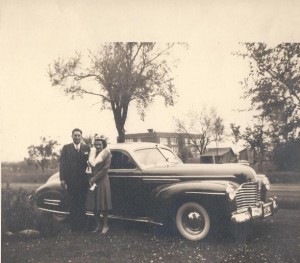
Momo and Husband Two in the 1940’s. The cars change, the husbands change, the furs stayed.
Husband Two, after 20 years, also announced he was moving in a new direction, another shock to her system. By then, she was in her mid 50’s and time was marching on. I would imagine she was frightened about her place in a society where everyone she knew was part of a couple. That’s how the world worked, and still does, in some ways, in the world of country clubs. It was particularly hard for women, she told me later, again advising me about the risks of divorce.
“In those days, we didn’t have a name for domestic violence, we just called it life” Gloria Steinem, in the upcoming documentary “Private Violence”
She still had the style and the charm and the ability to attract men, but again, not always the right ones. I understood that about her, as it took me years to get any of that right, and nothing in love is ever completely right. But she deserved more than what life brought her next. She met a man who came off as a quiet and proper person, almost “the demeanor of a preacher”, as my mother said, who hid what he was inside, a dangerous and violent alcoholic. He pushed her down one night, and injured her back. I only heard about it years later, when I was in my twenties. It may have happened once, maybe more. I never knew, she only admitted the one “incident”. Everyone kept it quiet. Violence like that wasn’t discussed anywhere, particularly in the country club set. It was hidden and as our next film calls it, it was “private” violence. It has a name now, given by Dr. Susan Weitzman after many years of research on what she calls “upscale violence” when she wrote the book Not to People like Us: Hidden Abuse in Upscale Marriages. That wasn’t available in the mid 1960’s. Nothing was. She did end that marriage, and moved on. There were a few other men, one old “beau” who lived in Florida, who she visited, who was a good man, but ill and that wasn’t in Momo’s plans. As smart as she was about so many things, my sense was that she never seemed to be able to feel completely appreciated by the men she knew.
“There’s no beauty without poignancy and there’s no poignancy without the feeling that it’s going, men, names, books, houses–bound for dust–mortal--” F Scott Fitzgerald, the Beautiful and the Damned”
I can picture her now as my plump, soft, silver haired grandmother with the feisty spirit and the sometimes sharp tongue, but I also like to go back into her history and freeze her in the early years of the past century and in the 1920’s, before the world taught her that love and life weren’t always easy and that beauty fades and with that, lives change. I’ve kept her there in the pictures for this story. I think she would have liked that.
I live in her home now, a home I spent so much time in as a child. I would visit often and have overnight stays here in the pale yellow guest room I loved. By then, she lived alone and loved the company, and would spoil all of her grandchildren with her famous southern fried chicken and delicious desserts. She had beautiful things and took pride in her sparkling clean home full of treasures amassed during her long life. She could tell you stories of each piece acquired from the Steinway upright piano to the prize winning chandelier she’d bought in New York. Her jewelry and furs were a treasure trove to a young girl who loved to play dress up. She would pull those out for special occasions. When you came to pick her up for those occasions, in her later years, she’d greet you at her door swathed in perfume, perfectly made up, and dressed impeccably. At 13, much to my mother’s horror, she took me to see “Sonny and Cher” live in Chicago, introducing their film “Chastity”. My first visit to Saks Fifth Avenue was with her. She was, I always thought, terribly glamorous.
She loved to travel, she still loved parties, men, her church, shopping, the theater, and music, and she had a genius for investing her money. My mother tells me she would outdo her financial advisers in picking the right stocks, something I’ve been told about my older brother, Norm. Perhaps he got that from her. Her finest investment made her a bit famous in the 80’s and 90’s in the heyday of Gateway computers as “Ted Waitt’s grandmother who loaned him a 15,000 CD”. (The loan became 10,000 from the bank, much to my brother’s dismay). The media called her “Momo” sometimes, in the stories. So did we. Money was still important to her. When she was assigned as our babysitter, she’d occasionally “disinherit” us, thinking that would be the worst punishment we could get, particularly as obnoxious teenagers. It didn’t stick. She’d open her door to any of us the next day, with a big hug and “well, come in, honey”. She was generous. Her favorite saying when you tried to buy something yourself was “Save your confederate money, dear, the South may rise again”. I hoped it didn’t. She loved her home, as many Cancerian girls do. She was a creature of habit, and when I would visit, in the early evenings, she would give you a bottle of Squirt and bowl of cocktail nuts, pour herself a Scotch and tell me stories, both of the highlights of her life, and the low points, something she wasn’t afraid to share.
She taught me to cook her famous fried chicken, to turn a bit in pictures to make yourself look slimmer, to play “Clair de Lune” on her prized piano, which I can no longer do. She taught me how to clean that gorgeous chandelier, and she also taught me survival. She lived into her late 80’s and braved some health problems before she died one Christmas season. I made many of the mistakes she made, particularly with men, and knowing that,I always tried to do things to lift her loneliness a little. Every New Year’s Eve, I would call her, from wherever I was, and wish her Happy New Year. I’m late this year, but wherever you are, Momo, Happy New Year. I hope your dance card is full, with something or someone you love and I hope it’s a place as beautiful as you.
Comments (8)







































